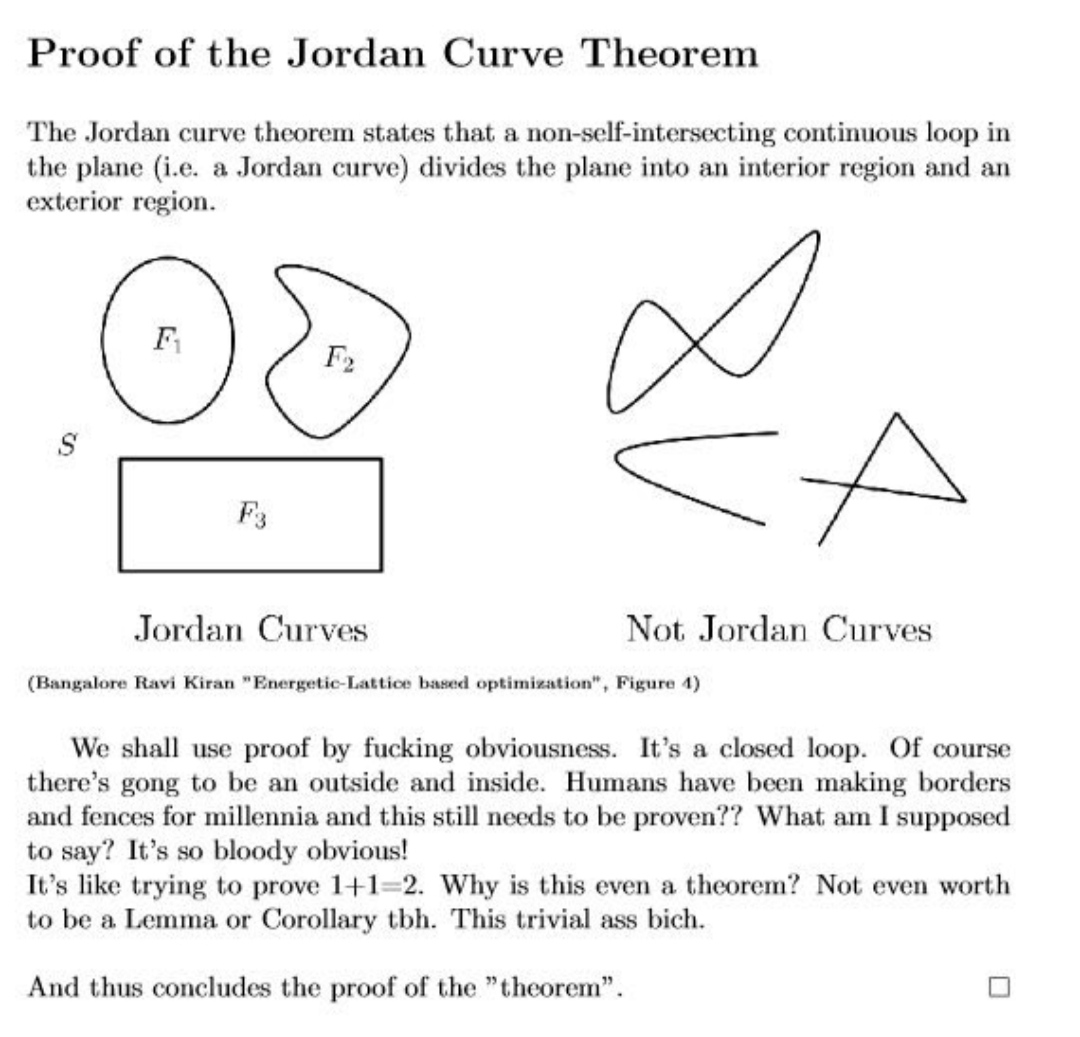this post was submitted on 20 Oct 2024
363 points (96.7% liked)
Math Memes
1530 readers
1 users here now
Memes related to mathematics.
Rules:
1: Memes must be related to mathematics in some way.
2: No bigotry of any kind.
founded 1 year ago
MODERATORS
you are viewing a single comment's thread
view the rest of the comments
view the rest of the comments

This guy would not be happy to learn about the 1+1=2 proof
One part of the 360 page proof in Principia Mathematica:
It's not a 360 page proof, it just appears that many pages into the book. That's the whole proof.
Weak-ass proof. You could fit this into a margin.
Upvoting because I trust you it's funny, not because I understand.
It's a reference to Fermat's Last Theorem.
Tl;dr is that a legendary mathematician wrote in a margin of a book that he's got a proof of a particular proposition, but that the proof is too long to fit into said margin. That was around the year 1637. A proof was finally found in 1994.
I thought it must be sonething like that, I expected it to be more specific though :)
Principia mathematica should not be used as source book for any actual mathematics because it’s an outdated and flawed attempt at formalising mathematics.
Axiomatic set theory provides a better framework for elementary problems such as proving 1+1=2.
I'm not believing it until I see your definition of arithmetical addition.
Friggin nerds!
A friend of mine took Introduction to Real Analysis in university and told me their first project was “prove the real number system.”
Real analysis when fake analysis enters
I don't know about fake analysis but I imagine it gets quite complex
Isn't "1+1" the definition of 2?
That assumes that 1 and 1 are the same thing. That they’re units which can be added/aggregated. And when they are that they always equal a singular value. And that value is 2.
It’s obvious but the proof isn’t about stating the obvious. It’s about making clear what are concrete rules in the symbolism/language of math I believe.
It depends on what you mean by well defined. At a fundamental level, we need to agree on basic definitions in order to communicate. Principia Mathematica aimed to set a formal logical foundation for all of mathematics, so it needed to be as rigid and unambiguous as possible. The proof that 1+1=2 is just slightly more verbose when using their language.
Not a math wizard here: wouldn't either of the 1s stop being 1s if they were anything but exactly 1.0? And instead become 1.xxx or whatever?
1.xxx and 1.xxy are still 2 numbers, so 1+1=2.
Gottem.
In base 2 binary for example the digits are 0 and 1. Counting from 0 up would look like 0, 1, 10, 11, 100, 101, 110, 111, 1000, 1001, 1010, 1011, 1100, 1101, 1110, 1111, 10000, etc
In that case 1 + 1 = 10
Using the Peano axioms, which are often used as the basis for arithmetic, you first define a successor function, often denoted as •' and the number 0. The natural numbers (including 0) then are defined by repeated application of the successor function (of course, you also first need to define what equality is):
0 = 0
1 := 0'
2 := 1' = 0''
etc
Addition, denoted by •+• , is then recursively defined via
a + 0 = a
a + b' = (a+b)'
which quickly gives you that 1+1=2. But that requires you to thake these axioms for granted. Mathematicians proved it with fewer assumptions, but the proof got a tad verbose
The "=" symbol defines an equivalence relation. So "1+1=2" is one definition of "2", defining it as equivalent to the addition of 2 identical unit values.
2*1 also defines 2. As does any even quantity divided by half it's value. 2 is also the successor to 1 (and predecessor to 3), if you base your system on counting (or anti-counting).
The youtuber Vihart has a video that whimsically explores the idea that numbers and operations can be looked at in different ways.
I'll always upvote a ViHart video.
Or the pigeonhole principle.
That's a bit of a misnomer, it's a derivation of the entirety of the core arithmetical operations from axioms. They use 1+1=2 as an example to demonstrate it.